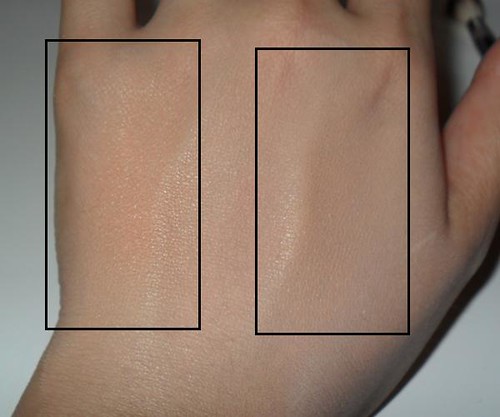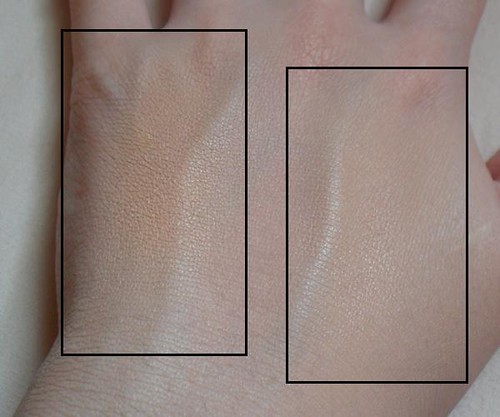There have been so many horror stories about getting a white cast from using this infamous, much-hated, and much-loved powder.
Well, I have to say that if you do, then you’re probably applying too much and not buffing out enough. That said, I think we do deserve to have products (especially ones that cost this much) work easily for us.
MUFE HD powder is 100% silica, which is a spherical mineral that gives a silky slip to your skin, absorbs oil, and helps to diffuse light, much like a silicone primer. Brands like MAC, E.L.F., Laura Mercier also carry similar products. However, while I do love how this feels, I can say that I will never buy this product from MUFE again. This is simply because 100% silica costs a mere fraction of the price they are charging; this is a common, cheap mineral ingredient in a lot of makeup products, and we’re being grossly overcharged.
That said, I probably have to thank MUFE for introducing me to silica powder, as I love it and will probably never stop using it for its ability to set products without changing their color, mattify skin and diminish lines.
HOW TO USE IT?
As a dry primer before powder products.
If you use wet/moist products as part of your routine (creams, sunblock, serums, foundations, concealers, cream blushes, moist highlighters), you probably apply them before you apply any powder ones (mineral powder, powder blush, powder highlighters).
Now, as some of us know, applying powder right over wet or creamy products can cause them to really cake up and grab in areas, darkening what we want to lighten up in the first places.
BUT, if you set your creams/bases with silica BEFORE applying your blusher and face powder, etc, they will not only go on really evenly, but it gets rid of any white silica cast you may have.
Of course, if you’re heavy-handed with your powders in general, anything will give you an unnatural cast, so don’t blame the silica.
Below, I have a little experiment to demonstrate.
Then I’m applying a patch of salmon-colored corrector powder (Everyday Minerals Abbott’s Perk Me Up) and buffing in with a soft fluffy eyeshadow blender.
What you’ll see in the series of pictures below is how the powder will grab on the concealer and darken in the patch (left side) that has not been set with silica.
Pic 1: Artificial light, with flash.
See how the powder is already orange-looking. And see how the peach powder on the right side has not grabbed, and does NOT have the white silica cast that we are all so afraid of.
Pic. 2: Natural Light, no flash.
In natural light it’s worse. The cakiness comes out, the powder is obviously darkened, and skin texture is dull and dry-looking, which can be a disaster for the eye area and zits. (And this is right after application, before sweat and oxidation makes it worse.)
The right side, however, looks as perfect as before, regardless of lighting.
REMEMBER:
- Silica acts as a non-sticky surface which prevents powder from sucking up the moisture or oils in your skin and darkening in the process. This is especially important for areas where you tend to apply more products, such as zits and under the eyes. It also helps to prevent overly-strong blush as you’re forced to slowly build up.
- After you apply your powder foundation, etc, don’t forget to use a clean brush or powder puff to buff off any excess. Because you have a layer of silica, the excess will slip off easier, leaving you with just enough product. If you skip this step, it’s likely that there is too much powder in areas of your face, which will oxidize and cake over the day, and look horrid in photographs, regardless of what you use.




In the fast-paced world of business, first impressions matter — and so does presentation. Whether you’re preparing for a major conference, a corporate photoshoot, or an important client event, your professional image plays a big role in how others perceive you and your brand. Makeup has become an essential part of modern corporate grooming, enhancing confidence, sophistication, and polish.
ReplyDeleteAt The Make-Up Box, we understand that corporate beauty isn’t just about looking good — it’s about feeling empowered, confident, and ready to lead. That’s why we offer specialised corporate package makeup services designed to help professionals look their best for every business occasion. But one key question often arises: When should you schedule your makeup corporate package trial?
For a flawless, photo-ready finish, the Make Up For Ever HD Powder is a pro favorite. To use it correctly, always apply it after your liquid or cream foundation and concealer. The key is moderation; a light dusting is all you need to set your makeup and control shine. You can find detailed visual guides and tutorials on platforms like scribddownloader, which often host comprehensive beauty guides. Use a fluffy powder brush or a velour puff, focusing on your T-zone and areas where you tend to get oily. Gently press or roll the powder into the skin—avoid dragging, as this can disrupt your base makeup. This silica-based powder is fantastic for blurring fine lines and pores without adding color or texture. Remember, it's translucent, so it won't alter your foundation shade. Finally, always tap off any excess from your brush before application to avoid a chalky, overdone look. This final step ensures your complexion looks naturally perfected, both in person and on camera.
ReplyDelete